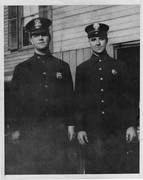- Joined
- Aug 29, 2008
- Messages
- 2,487
Does anyone know what type of facility is across from 88/38? Is it a school or a hospital maybe? Just curious.
scoobyd said:Aquinas High School. Another thing about that house- despite being busy from the 60's on, it is perhaps one of the best maintained. A lot of pride has gone in to the place and continues to. "Too busy" never caught on there. They don't eat too badly either.


scoobyd said:Another fact if I"m not mistaken- the late Vincent Albanese- senior man of L 38- did 38 years in 38 truck. Retired and passed away not long ago. Another legend I didn't get to know- Lt. Leo "Granpa" Fracassi. WWII vet and did over 40 years FDNY. I think over 20 of them in L 38. And the hardest years to do.
LT Leo Fracassi was a big name in LAD*38 in the FDNY WAR YEARS & later.....but also another name during another WAR before becoming an FDNY Member & that was WW-2 when he was General Patton's Aide hence the stars on the bumpers of their Rigs through the years .scoobyd said:Another fact if I"m not mistaken- the late Vincent Albanese- senior man of L 38- did 38 years in 38 truck. Retired and passed away not long ago. Another legend I didn't get to know- Lt. Leo "Granpa" Fracassi. WWII vet and did over 40 years FDNY. I think over 20 of them in L 38. And the hardest years to do.
68jk09 said:LT Leo Fracassi was a big name in LAD*38 in the FDNY WAR YEARS & later.....but also another name during another WAR before becoming an FDNY Member & that was WW-2 when he was General Patton's Aide hence the stars on the bumpers of their Rigs through the years .scoobyd said:Another fact if I"m not mistaken- the late Vincent Albanese- senior man of L 38- did 38 years in 38 truck. Retired and passed away not long ago. Another legend I didn't get to know- Lt. Leo "Granpa" Fracassi. WWII vet and did over 40 years FDNY. I think over 20 of them in L 38. And the hardest years to do.
3511 said:E38, among others, interchanged with E88.
L33, among others, with L38.
Both companies ran with with 3 or 4 relocated sections during the height of the War Years in the late 60's, early 70"s.
Other facts about "First Due at the Zoo":
They really are, first due at the Bronx Zoo.
The only firehouse in the city designed by theater architects. Look at the Amsterdam Theatre on West 42d Street. ..same architects. Marble walls, not tile, and mahogany trim and bannisters throughout the house. The beds in the bunk rooms are still the originals from 1908.
During WWII, Chief of Department in Command John J. McCarthy (the only one to ever hold that title) and First Deputy Commissioner Hugh Halligan ran the FDNY during the war effort. Both started as Probes together in E88 and left to serve as US Army officers in WWI. Halligan returned and signed out in the house watch journal on his last day of duty after over 40 years of service.
L38 received the Stapleton Award as the best run company in the job in the late 1930's.
Known as a "West Point House" for their professionalism. A jewel of an assignment for any officer or firefighter.
In 1974, E88 led the city in runs, L38 the Bronx in workers. Both among the top 10 in the city from the 1960's through the 90s.
Featured in Brian Hickey 's "Bothers in Battle" documentary.
Perhaps the best menu in the city. 1st due on Arthur Avenue, which is around the corner.
RIP to FF Billy Koesterer, E88, who died of cancer earlier this month. Age 42. Left a wife and 3 young children. One hell of a guy and a great fireman.








